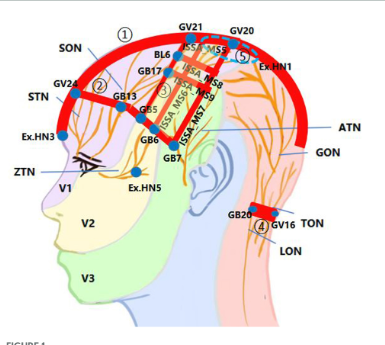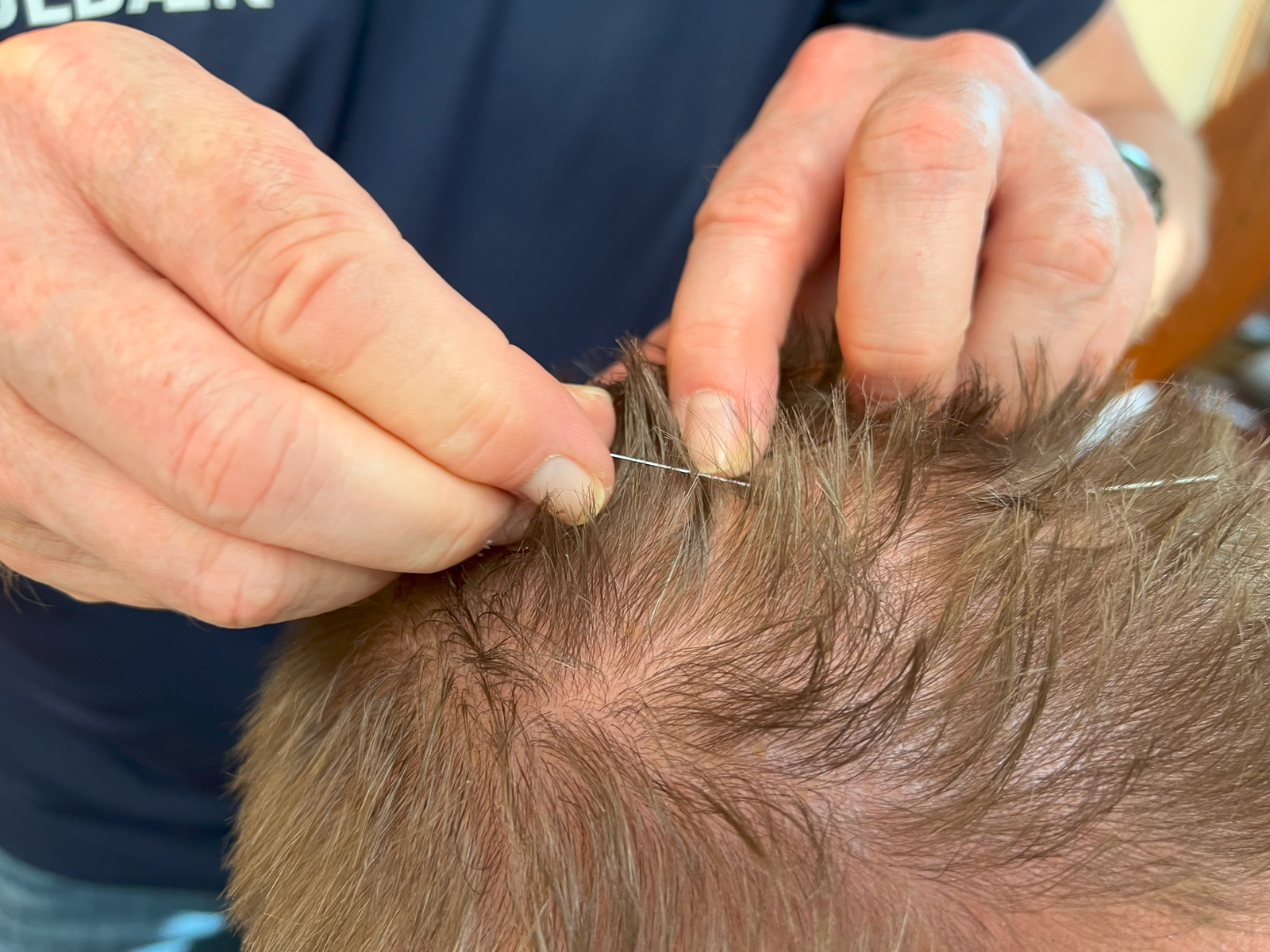
in treating brain diseases (© 2023 Jin, Jin, Jin, Zheng, He and Li. This is an
open-access article distributed under the terms
of the Creative Commons Attribution License
(CC BY).)
A great review on Scalp Acupuncture
A research team from the USA has published a review on the mechanisms of Scalp Acupuncture (SA). Scalp acupuncture, a modern acupuncture therapy, has been extensively used in the treatment of various brain diseases, such as stroke and headache. This therapy has accumulated a wealth of experience and numerous success cases. The review explores a novel perspective on the mechanisms of SA in treating brain diseases, focusing on its effects on cerebral blood flow (CBF).
To date, abundant evidence has shown that CBF is significantly increased by stimulating specific SA points, areas, or nerves innervating the scalp. This increase in CBF correlates with the immediate and long-term improvement of symptoms in brain diseases. Over time, the neural pathways that enhance CBF through the stimulation of the trigeminal, facial, and cervical nerves have been gradually elucidated. Additionally, the core SA points or areas frequently used for brain diseases can be rationally explained by the characteristics of nerve distribution, including nerve overlap or convergence in certain parts of the scalp.
Current evidence suggests that the efficacy of SA in treating brain diseases, particularly ischemic strokes, is primarily achieved by stimulating the scalp nerves, especially the trigeminal nerve, to improve CBF. While the mechanisms of SA in treating various brain diseases may be multifaceted, understanding the neural regulation of SA on CBF captures the main aspects of its therapeutic mechanisms. This understanding also facilitates the elucidation of other mechanisms, which may be of greater significance for further clinical applications.
Mechanism of Scalp Acupuncture in Chinese Medicine
The head (brain) is considered the house of Yuan Shen, or the primary Shen, in Chinese Medicine. All mental and neurological diseases, such as pain, stroke, dementia, Parkinson’s disease, depression, and insomnia, can be regarded as Shen disorders. All Yang channels and Yin channels connect to the brain directly or indirectly, making the brain the central hub of the entire meridian/channel network. In Chinese Medicine, the primary function of acupuncture is to move Qi and blood and regulate Shen. The stimulation of specific scalp points directly regulates Shen and the flow of Qi and blood, thereby restoring balance and promoting healing.
This holistic approach not only addresses the physical symptoms but also targets the underlying imbalances of Shen, Qi, and blood that contribute to brain diseases (Shen disorders). By integrating the principles of Chinese Medicine with modern neurophysiological insights, scalp acupuncture offers a comprehensive and effective treatment modality for brain diseases.
Reference
Jin, G., Jin, L.L., Jin, B.X., Zheng, J., He, B.J., & Li, S.J. (2023). Neural control of cerebral blood flow: scientific basis of scalp acupuncture in treating brain diseases. Frontiers in Neuroscience, 17.
Creative Commons Attribution License (CC BY).
En fremragende anmeldelse af Skalpakupunktur
Et forskerteam fra USA har offentliggjort en anmeldelse om mekanismerne bag Skalpakupunktur (SA). Skalpakupunktur, en moderne akupunkturterapi, er blevet brugt omfattende i behandlingen af forskellige hjernesygdomme, såsom slagtilfælde og hovedpine. Denne terapi har akkumuleret en stor mængde erfaring og talrige succesrige tilfælde. Anmeldelsen udforsker et nyt perspektiv på mekanismerne bag SA i behandlingen af hjernesygdomme, med fokus på dens effekt på cerebral blodgennemstrømning (CBF).
Indtil videre har overvældende beviser vist, at CBF øges markant ved at stimulere specifikke SA-punkter, områder eller nerver, der innerverer hovedbunden. Denne stigning i CBF korrelerer med den umiddelbare og langsigtede forbedring af symptomerne på hjernesygdomme. Over tid er de neurale veje, der øger CBF gennem stimulering af trigeminus-, ansigts- og cervikale nerver, gradvist blevet klarlagt. Derudover kan de kerne SA-punkter eller områder, der ofte bruges til hjernesygdomme, forklares rationelt ved karakteristika af nervedistribution, inklusive nerveoverlap eller konvergens i bestemte dele af hovedbunden.
Nuværende beviser tyder på, at effektiviteten af SA i behandlingen af hjernesygdomme, især iskæmiske slagtilfælde, primært opnås ved at stimulere hovedbundsnervene, især trigeminusnerven, for at forbedre CBF. Mens mekanismerne bag SA i behandlingen af forskellige hjernesygdomme kan være mangesidede, fanger forståelsen af den neurale regulering af SA på CBF de væsentligste aspekter af dens terapeutiske mekanismer. Denne forståelse letter også belysningen af andre mekanismer, som kan være af større betydning for yderligere kliniske anvendelser.
Mekanismen bag Skalpakupunktur i Kinesisk Medicin
Hovedet (hjernen) betragtes som huset for Yuan Shen, eller den primære Shen, i Kinesisk Medicin. Alle mentale og neurologiske sygdomme, såsom smerte, slagtilfælde, demens, Parkinsons sygdom, depression og søvnløshed, kan betragtes som Shen-forstyrrelser. Alle Yang-kanaler og Yin-kanaler forbinder til hjernen direkte eller indirekte, hvilket gør hjernen til det centrale knudepunkt i hele meridian netværket. I Kinesisk Medicin er den primære funktion af akupunktur at bevæge Qi og blod og regulere Shen. Stimulering af specifikke skalpunkter regulerer direkte Shen og strømmen af Qi og blod, og dermed genopretter balancen og fremmer heling.
Denne holistiske tilgang adresserer ikke kun de fysiske symptomer, men målretter også de underliggende ubalancer af Shen, Qi og blod, der bidrager til hjernesygdomme (Shen-forstyrrelser). Ved at integrere principperne fra Kinesisk Medicin med moderne neurofysiologiske indsigter, tilbyder skalpakupunktur en omfattende og effektiv behandlingsmodalitet for hjernesygdomme.
